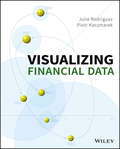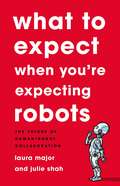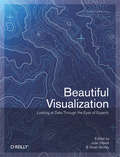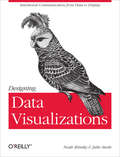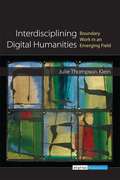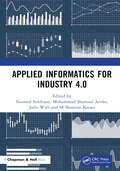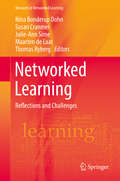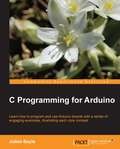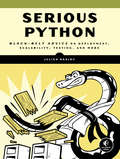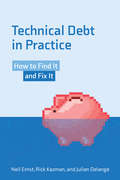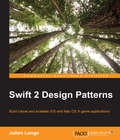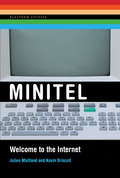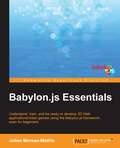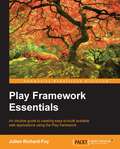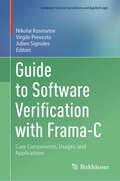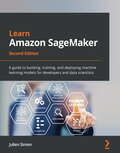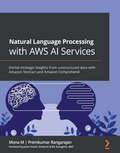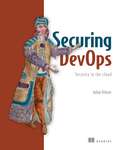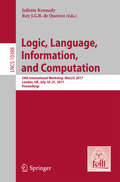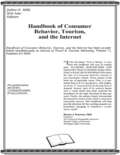- Table View
- List View
Visualizing Financial Data
by Piotr Kaczmarek Julie RodriguezA fresh take on financial data visualization for greater accuracy and understanding Visualizing Financial Data shows you how to design dynamic, best-of-breed visualizations for better communication of financial data. This book provides a comprehensive set of visualizations tailored to the most common requirements for corporate financial reporting, as well as portfolio, mutual fund, and hedge fund management. This highly visual, full color book showcases a series of cases that push data communication conventions forward, demonstrating and contrasting traditional bar, line, and pie charts against more modern visual methods. The companion website features all of the visualizations discussed, and provides the underlying datasets that you can use to practice on your own or customize the visualizations for your own use. Get a fresh take on visualizations and insight you need to communicate financial data better than ever before. Expand the boundaries of data visualization conventions Optimize data communications, understanding, and disclosure Learn new approaches to traditional charts and visualizations Create exemplary visualizations Visualizing Financial Data shows you newer, better ways of communicating the full meaning of the data, to support efficient, timely, and effective decision-making.
What To Expect When You're Expecting Robots: The Future of Human-Robot Collaboration
by Laura Major Julie ShahThe next generation of robots will be truly social, but can we make sure that they play well in the sandbox?Most robots are just tools. They do limited sets of tasks subject to constant human control. But a new type of robot is coming. These machines will operate on their own in busy, unpredictable public spaces. They'll ferry deliveries, manage emergency rooms, even grocery shop. Such systems could be truly collaborative, accomplishing tasks we don't do well without our having to stop and direct them. This makes them social entities, so, as robot designers Laura Major and Julie Shah argue, whether they make our lives better or worse is a matter of whether they know how to behave.What to Expect When You're Expecting Robots offers a vision for how robots can survive in the real world and how they will change our relationship to technology. From teaching them manners, to robot-proofing public spaces, to planning for their mistakes, this book answers every question you didn't know you needed to ask about the robots on the way.
Beautiful Visualization: Looking at Data through the Eyes of Experts
by Noah Iliinsky Julie SteeleVisualization is the graphic presentation of data -- portrayals meant to reveal complex information at a glance. Think of the familiar map of the New York City subway system, or a diagram of the human brain. Successful visualizations are beautiful not only for their aesthetic design, but also for elegant layers of detail that efficiently generate insight and new understanding.This book examines the methods of two dozen visualization experts who approach their projects from a variety of perspectives -- as artists, designers, commentators, scientists, analysts, statisticians, and more. Together they demonstrate how visualization can help us make sense of the world.Explore the importance of storytelling with a simple visualization exerciseLearn how color conveys information that our brains recognize before we're fully aware of itDiscover how the books we buy and the people we associate with reveal clues to our deeper selvesRecognize a method to the madness of air travel with a visualization of civilian air trafficFind out how researchers investigate unknown phenomena, from initial sketches to published papers Contributors include:Nick Bilton,Michael E. Driscoll,Jonathan Feinberg,Danyel Fisher,Jessica Hagy,Gregor Hochmuth,Todd Holloway,Noah Iliinsky,Eddie Jabbour,Valdean Klump,Aaron Koblin,Robert Kosara,Valdis Krebs,JoAnn Kuchera-Morin et al.,Andrew Odewahn,Adam Perer,Anders Persson,Maximilian Schich,Matthias Shapiro,Julie Steele,Moritz Stefaner,Jer Thorp,Fernanda Viegas,Martin Wattenberg,and Michael Young.
Designing Data Visualizations: Representing Informational Relationships
by Noah Iliinsky Julie SteeleData visualization is an efficient and effective medium for communicating large amounts of information, but the design process can often seem like an unexplainable creative endeavor. This concise book aims to demystify the design process by showing you how to use a linear decision-making process to encode your information visually.Delve into different kinds of visualization, including infographics and visual art, and explore the influences at work in each one. Then learn how to apply these concepts to your design process.Learn data visualization classifications, including explanatory, exploratory, and hybridDiscover how three fundamental influences—the designer, the reader, and the data—shape what you createLearn how to describe the specific goal of your visualization and identify the supporting dataDecide the spatial position of your visual entities with axesEncode the various dimensions of your data with appropriate visual properties, such as shape and colorSee visualization best practices and suggestions for encoding various specific data types
Interdisciplining Digital Humanities: Boundary Work In An Emerging Field
by Julie Thompson KleinInterdisciplining Digital Humanities sorts through definitions and patterns of practice over roughly sixty-five years of work, providing an overview for specialists and a general audience alike. It is the only book that tests the widespread claim that Digital Humanities is interdisciplinary. By examining the boundary work of constructing, expanding, and sustaining a new field, it depicts both the ways this new field is being situated within individual domains and dynamic cross-fertilizations that are fostering new relationships across academic boundaries. It also accounts for digital reinvigorations of "public humanities" in cultural heritage institutions of museums, archives, libraries, and community forums.
Applied Informatics for Industry 4.0
by Nazmul Siddique M Shamim Kaiser Mohammad Shamsul Arefin Julie WallApplied Informatics for Industry 4.0 combines the technologies of computer science and information science to assist in the management and processing of data to provide different types of services. Due to the adaptation of 4.0 IR-related technologies, applied informatics is playing a vital role in different sectors such as healthcare, complex system design and privacy-related issues. This book focuses on cutting edge research from the fields of informatics and complex industrial systems, and will cover topics including health informatics, bioinformatics, brain informatics, genomics and proteomics, data and network security and more. The text will appeal to beginners and advanced researchers in the fields of computer science, information sciences, electrical and electronic engineering and robotics.
Networked Learning: Reflections And Challenges (Research in Networked Learning)
by Thomas Ryberg Maarten De Laat Nina Bonderup Dohn Susan Cranmer Julie-Ann SimeThe book is based on nine selected, peer-reviewed papers presented at the 10th biennial Networked Learning Conference (NLC) 2016 held in Lancaster. Informed by suggestions from delegates, the nine papers have been chosen by the editors (who were the Chairs of the Conference) as exemplars of cutting edge research on networked learning. Further reviews of all papers were conducted once they were revised as chapters for the book. The chapters are organized into two sections: 1) Situating Networked Learning: Looking Back - Moving Forward, 2) New Challenges: Designs for Networked Learning in the Public Arena. Further, we include an introduction which looks at the evolution of trends in Networked Learning through a semantic analysis of conference papers from the 10 conferences. A final chapter draws out perspectives from the chapters and discusses emerging issues. The book is the fifth in the Networked Learning Conference Series.
C Programming for Arduino
by Julien BayleWritten as a practical Packt book brimming with engaging examples, C Programming for Arduino will help those new to the amazing open source electronic platform so that they can start developing some great projects from the very start.This book is great for people who want to learn how to design & build their own electronic devices. From interaction design art school students to the do-it-yourself hobbyist, or even simply people who want to learn electronics, this book will help by adding a new way to design autonomous but connected devices.
Econometric Analysis of Carbon Markets: The European Union Emissions Trading Scheme and the Clean Development Mechanism
by Julien ChevallierThrough analysis of the European Union Emissions Trading Scheme (EU ETS) and the Clean Development Mechanism (CDM), this book demonstrates how to use a variety of econometric techniques to analyze the evolving and expanding carbon markets sphere, techniques that can be extrapolated to the worldwide marketplace. It features stylized facts about carbon markets from an economics perspective, as well as covering key aspects of pricing strategies, risk and portfolio management.
Serious Python: Black-Belt Advice on Deployment, Scalability, Testing, and More
by Julien DanjouAn indispensable collection of practical tips and real-world advice for tackling common Python problems and taking your code to the next level. Features interviews with high-profile Python developers who share their tips, tricks, best practices, and real-world advice gleaned from years of experience.Sharpen your Python skills as you dive deep into the Python programming language with Serious Python. You'll cover a range of advanced topics like multithreading and memorization, get advice from experts on things like designing APIs and dealing with databases, and learn Python internals to help you gain a deeper understanding of the language itself. Written for developers and experienced programmers, Serious Python brings together over 15 years of Python experience to teach you how to avoid common mistakes, write code more efficiently, and build better programs in less time. As you make your way through the book's extensive tutorials, you'll learn how to start a project and tackle topics like versioning, layouts, coding style, and automated checks. You'll learn how to package your software for distribution, optimize performance, use the right data structures, define functions efficiently, pick the right libraries, build future-proof programs, and optimize your programs down to the bytecode. You'll also learn how to: - Make and use effective decorators and methods, including abstract, static, and class methods- Employ Python for functional programming using generators, pure functions, and functional functions- Extend flake8 to work with the abstract syntax tree (AST) to introduce more sophisticated automatic checks into your programs- Apply dynamic performance analysis to identify bottlenecks in your code- Work with relational databases and effectively manage and stream data with PostgreSQLIf you've been looking for a way to take your Python skills from good to great, Serious Python will help you get there. Learn from the experts and get seriously good at Python with Serious Python!
Technical Debt in Practice: How to Find It and Fix It
by Rick Kazman Neil Ernst Julien DelangeThe practical implications of technical debt for the entire software lifecycle; with examples and case studies.Technical debt in software is incurred when developers take shortcuts and make ill-advised technical decisions in the initial phases of a project, only to be confronted with the need for costly and labor-intensive workarounds later. This book offers advice on how to avoid technical debt, how to locate its sources, and how to remove it. It focuses on the practical implications of technical debt for the entire software life cycle, with examples and case studies from companies that range from Boeing to Twitter. Technical debt is normal; it is part of most iterative development processes. But if debt is ignored, over time it may become unmanageably complex, requiring developers to spend all of their effort fixing bugs, with no time to add new features--and after all, new features are what customers really value. The authors explain how to monitor technical debt, how to measure it, and how and when to pay it down. Broadening the conventional definition of technical debt, they cover requirements debt, implementation debt, testing debt, architecture debt, documentation debt, deployment debt, and social debt. They intersperse technical discussions with "Voice of the Practitioner" sidebars that detail real-world experiences with a variety of technical debt issues.
Swift Design Patterns
by Julien LangeThis book is intended for competent Swift developers who want to apply enduring design patterns with Swift to structure and scale their application code.
Swarm Intelligence Based Optimization
by Patrick Siarry Lhassane Idoumghar Julien LepagnotThis book constitutes the thoroughly refereed post-conference proceedings of the 1st International Conference on Swarm Intelligence Based Optimization, ICSIBO 2014, held in Mulhouse, France, in May 2014. The 20 full papers presented were carefully reviewed and selected from 48 submissions. Topics of interest presented and discussed in the conference focuses on the theoretical progress of swarm intelligence metaheuristics and their applications in areas such as: theoretical advances of swarm intelligence metaheuristics, combinatorial, discrete, binary, constrained, multi-objective, multi-modal, dynamic, noisy, and large-scale optimization, artificial immune systems, particle swarms, ant colony, bacterial foraging, artificial bees, fireflies algorithm, hybridization of algorithms, parallel/distributed computing, machine learning, data mining, data clustering, decision making and multi-agent systems based on swarm intelligence principles, adaptation and applications of swarm intelligence principles to real world problems in various domains.
Minitel: Welcome to the Internet (Platform Studies)
by Julien Mailland Kevin DriscollThe first scholarly book in English on Minitel, the pioneering French computer network, offers a history of a technical system and a cultural phenomenon.A decade before the Internet became a medium for the masses in the United States, tens of millions of users in France had access to a network for e-mail, e-commerce, chat, research, game playing, blogging, and even an early form of online porn. In 1983, the French government rolled out Minitel, a computer network that achieved widespread adoption in just a few years as the government distributed free terminals to every French telephone subscriber. With this volume, Julien Mailland and Kevin Driscoll offer the first scholarly book in English on Minitel, examining it as both a technical system and a cultural phenomenon. Mailland and Driscoll argue that Minitel was a technical marvel, a commercial success, and an ambitious social experiment. Other early networks may have introduced protocols and software standards that continue to be used today, but Minitel foretold the social effects of widespread telecomputing. They examine the unique balance of forces that enabled the growth of Minitel: public and private, open and closed, centralized and decentralized. Mailland and Driscoll describe Minitel's key technological components, novel online services, and thriving virtual communities. Despite the seemingly tight grip of the state, however, a lively Minitel culture emerged, characterized by spontaneity, imagination, and creativity. After three decades of continuous service, Minitel was shut down in 2012, but the history of Minitel should continue to inform our thinking about Internet policy, today and into the future.
Babylon.js Essentials
by Julien Moreau-MathisUnderstand, train, and be ready to develop 3D Web applications/video games using the Babylon.js framework, even for beginners About This Book * Understand the basics of 3D (along with the theory) before practicing * Each mini-project provides previous features, alongside the new feature you are learning, to supply the examples * Learn from the best of the best, a developer at Microsoft, France Who This Book Is For Babylon.JS Essentials is intended for developers who want to enter the world of 3D development for the Web, or developers who want to add the Babylon.js framework to their skill set. The notion of Oriented Object Programming would be helpful to understand the architecture of the Babylon.js framework. Also, a familiarity with Web development would be useful, to understand the principles used. What You Will Learn * Understand what the TypeScript language is and its benefits (compared to JavaScript) in large projects such as 3D engines * Learn the basics of 3D using Babylon.js without too much theory but with an emphasis on practice, for a better understanding of the architecture * Know the usage of Material--a fundamental principle of 3D engines in Babylon.js--and then customize the appearance of 3D objects * Integrate collisions and physics in gameplay. Understand the notion of impostor for physics simulation * Manage, create, and spatialize audio tracks in 3D scenes * Go further with the Babylon.js framework to create actions on events * Create rendering effects provided by the Babylon.js framework, such as post-processes In Detail Are you familiar with HTML5? Do you want to build exciting games and Web applications? Then explore the exciting world of game and Web development with one of the best frameworks out there: Babylon.JS. Starting from the beginning, the book introduces the required basics for 3D development and the knowledge you need to use the Babylon.js framework. It focuses on the simplicity provided by Babylon.js and uses a combination of theory and practice. All the chapters are provided with example files ready to run; each example file provides the previously learned features of the framework. Finally, developers will be ready to easily understand new features added to the framework in the future. Style and approach The book is a comprehensive guide packed with ready-to-run examples with a mix of theory and practice.
Vert.x in Action: Asynchronous and Reactive Java
by Julien PongeVert.x in Action teaches you how to build production-quality reactive applications in Java. This book covers core Vert.x concepts, as well as the fundamentals of asynchronous and reactive programming. Learn to develop microservices by using Vert.x tools for database communications, persistent messaging, and test app resiliency. The patterns and techniques included here transfer to reactive technologies and frameworks beyond Vert.x.Summary As enterprise applications become larger and more distributed, new architectural approaches like reactive designs, microservices, and event streams are required knowledge. The Vert.x framework provides a mature, rock-solid toolkit for building reactive applications using Java, Kotlin, or Scala. Vert.x in Action teaches you to build responsive, resilient, and scalable JVM applications with Vert.x using well-established reactive design patterns. Purchase of the print book includes a free eBook in PDF, Kindle, and ePub formats from Manning Publications. About the technology Vert.x is a collection of libraries for the Java virtual machine that simplify event-based and asynchronous programming. Vert.x applications handle tedious tasks like asynchronous communication, concurrent work, message and data persistence, plus they&’re easy to scale, modify, and maintain. Backed by the Eclipse Foundation and used by Red Hat and others, this toolkit supports code in a variety of languages. About the book Vert.x in Action teaches you how to build production-quality reactive applications in Java. This book covers core Vert.x concepts, as well as the fundamentals of asynchronous and reactive programming. Learn to develop microservices by using Vert.x tools for database communications, persistent messaging, and test app resiliency. The patterns and techniques included here transfer to reactive technologies and frameworks beyond Vert.x. What's inside Building reactive services Responding to external service failures Horizontal scaling Vert.x toolkit architecture and Vert.x testing Deploying with Docker and Kubernetes About the reader For intermediate Java web developers. About the author Julien Ponge is a principal software engineer at Red Hat, working on the Eclipse Vert.x project. Table of Contents PART 1 - FUNDAMENTALS OF ASYNCHRONOUS PROGRAMMING WITH VERT.X 1 Vert.x, asynchronous programming, and reactive systems 2 Verticles: The basic processing units of Vert.x 3 Event bus: The backbone of a Vert.x application 4 Asynchronous data and event streams 5 Beyond callbacks 6 Beyond the event bus PART 2 - DEVELOPING REACTIVE SERVICES WITHT VERT.X 7 Designing a reactive application 8 The web stack 9 Messaging and event streaming with Vert.x 10 Persistent state management with databases 11 End-to-end real-time reactive event processing 12 Toward responsiveness with load and chaos testing 13 Final notes: Container-native Vert.x
Play Framework Essentials
by Julien Richard-FoyThis book targets Java and Scala developers who already have some experience in web development and who want to master Play framework quickly and efficiently. This book assumes you have a good level of knowledge and understanding of efficient Java and Scala code.
Guide to Software Verification with Frama-C: Core Components, Usages, and Applications (Computer Science Foundations and Applied Logic)
by Nikolai Kosmatov Virgile Prevosto Julien SignolesFrama-C is a popular open-source toolset for analysis and verification of C programs, largely used for teaching, experimental research, and industrial applications.With the growing complexity and ubiquity of modern software, there is increasing interest in code analysis tools at various levels of formalization to ensure safety and security of software products. Acknowledging the fact that no single technique will ever be able to fit all software verification needs, the Frama-C platform features a wide set of plug-ins that can be used or combined for solving specific verification tasks. This guidebook presents a large panorama of basic usages, research results, and concrete applications of Frama-C since the very first open-source release of the platform in 2008. It covers the ACSL specification language, core verification plug-ins, advanced analyses and their combinations, key ingredients for developing new plug-ins, as well as successful industrial case studies in which Frama-C has helped engineers verify crucial safety or security properties. Topics and features:* Gentle, example-based introduction to software specification and verification * Wide panorama of state-of-the-art specification and analysis techniques * Step-by-step guide to develop your own, tailor-made analysis on top of the platform* Inspiring success stories of Frama-C deployment on industrial code* More than 15 years of R&D on analysis and verification of C codeThis book is firmly rooted on the practice of software analysis, with numerous examples, exercises and application guidelines. As such, it is particularly well suited for software verification practitioners wishing to deploy verification on their code, as well as for undergraduate students with little or no experience in code analysis techniques. More advanced sections on the theoretical underpinnings of the analyzers will be of interest for graduate students and researchers.Nikolai Kosmatov is a Senior Researcher at Thales Research & Technology, France. Virgile Prevosto is a Senior Researcher and Julien Signoles is a Research Director, both at Université Paris-Saclay, CEA, List, France.
Learn Amazon SageMaker: A guide to building, training, and deploying machine learning models for developers and data scientists, 2nd Edition
by Julien SimonSwiftly build and deploy machine learning models without managing infrastructure and boost productivity using the latest Amazon SageMaker capabilities such as Studio, Autopilot, Data Wrangler, Pipelines, and Feature StoreKey FeaturesBuild, train, and deploy machine learning models quickly using Amazon SageMakerOptimize the accuracy, cost, and fairness of your modelsCreate and automate end-to-end machine learning workflows on Amazon Web Services (AWS)Book DescriptionAmazon SageMaker enables you to quickly build, train, and deploy machine learning models at scale without managing any infrastructure. It helps you focus on the machine learning problem at hand and deploy high-quality models by eliminating the heavy lifting typically involved in each step of the ML process. This second edition will help data scientists and ML developers to explore new features such as SageMaker Data Wrangler, Pipelines, Clarify, Feature Store, and much more. You'll start by learning how to use various capabilities of SageMaker as a single toolset to solve ML challenges and progress to cover features such as AutoML, built-in algorithms and frameworks, and writing your own code and algorithms to build ML models. The book will then show you how to integrate Amazon SageMaker with popular deep learning libraries, such as TensorFlow and PyTorch, to extend the capabilities of existing models. You'll also see how automating your workflows can help you get to production faster with minimum effort and at a lower cost. Finally, you'll explore SageMaker Debugger and SageMaker Model Monitor to detect quality issues in training and production. By the end of this Amazon book, you'll be able to use Amazon SageMaker on the full spectrum of ML workflows, from experimentation, training, and monitoring to scaling, deployment, and automation.What you will learnBecome well-versed with data annotation and preparation techniquesUse AutoML features to build and train machine learning models with AutoPilotCreate models using built-in algorithms and frameworks and your own codeTrain computer vision and natural language processing (NLP) models using real-world examplesCover training techniques for scaling, model optimization, model debugging, and cost optimizationAutomate deployment tasks in a variety of configurations using SDK and several automation toolsWho this book is forThis book is for software engineers, machine learning developers, data scientists, and AWS users who are new to using Amazon SageMaker and want to build high-quality machine learning models without worrying about infrastructure. Knowledge of AWS basics is required to grasp the concepts covered in this book more effectively. A solid understanding of machine learning concepts and the Python programming language will also be beneficial.
Natural Language Processing with AWS AI Services: Derive strategic insights from unstructured data with Amazon Textract and Amazon Comprehend
by Julien Simon Mona M Premkumar RangarajanWork through interesting real-life business use cases to uncover valuable insights from unstructured text using AWS AI servicesKey FeaturesGet to grips with AWS AI services for NLP and find out how to use them to gain strategic insightsRun Python code to use Amazon Textract and Amazon Comprehend to accelerate business outcomesUnderstand how you can integrate human-in-the-loop for custom NLP use cases with Amazon A2IBook DescriptionNatural language processing (NLP) uses machine learning to extract information from unstructured data. This book will help you to move quickly from business questions to high-performance models in production.To start with, you'll understand the importance of NLP in today's business applications and learn the features of Amazon Comprehend and Amazon Textract to build NLP models using Python and Jupyter Notebooks. The book then shows you how to integrate AI in applications for accelerating business outcomes with just a few lines of code. Throughout the book, you'll cover use cases such as smart text search, setting up compliance and controls when processing confidential documents, real-time text analytics, and much more to understand various NLP scenarios. You'll deploy and monitor scalable NLP models in production for real-time and batch requirements. As you advance, you'll explore strategies for including humans in the loop for different purposes in a document processing workflow. Moreover, you'll learn best practices for auto-scaling your NLP inference for enterprise traffic.Whether you're new to ML or an experienced practitioner, by the end of this NLP book, you'll have the confidence to use AWS AI services to build powerful NLP applications.What you will learnAutomate various NLP workflows on AWS to accelerate business outcomesUse Amazon Textract for text, tables, and handwriting recognition from images and PDF filesGain insights from unstructured text in the form of sentiment analysis, topic modeling, and more using Amazon ComprehendSet up end-to-end document processing pipelines to understand the role of humans in the loopDevelop NLP-based intelligent search solutions with just a few lines of codeCreate both real-time and batch document processing pipelines using PythonWho this book is forIf you're an NLP developer or data scientist looking to get started with AWS AI services to implement various NLP scenarios quickly, this book is for you. It will show you how easy it is to integrate AI in applications with just a few lines of code. A basic understanding of machine learning (ML) concepts is necessary to understand the concepts covered. Experience with Jupyter notebooks and Python will be helpful.
Securing DevOps: Security in the Cloud
by Julien VehentSummarySecuring DevOps explores how the techniques of DevOps and security should be applied together to make cloud services safer. This introductory book reviews the latest practices used in securing web applications and their infrastructure and teaches you techniques to integrate security directly into your product. You'll also learn the core concepts of DevOps, such as continuous integration, continuous delivery, and infrastructure as a service.Purchase of the print book includes a free eBook in PDF, Kindle, and ePub formats from Manning Publications.About the TechnologyAn application running in the cloud can benefit from incredible efficiencies, but they come with unique security threats too. A DevOps team's highest priority is understanding those risks and hardening the system against them.About the BookSecuring DevOps teaches you the essential techniques to secure your cloud services. Using compelling case studies, it shows you how to build security into automated testing, continuous delivery, and other core DevOps processes. This experience-rich book is filled with mission-critical strategies to protect web applications against attacks, deter fraud attempts, and make your services safer when operating at scale. You'll also learn to identify, assess, and secure the unique vulnerabilities posed by cloud deployments and automation tools commonly used in modern infrastructures. What's insideAn approach to continuous securityImplementing test-driven security in DevOpsSecurity techniques for cloud servicesWatching for fraud and responding to incidentsSecurity testing and risk assessmentAbout the ReaderReaders should be comfortable with Linux and standard DevOps practices like CI, CD, and unit testing.About the AuthorJulien Vehent is a security architect and DevOps advocate. He leads the Firefox Operations Security team at Mozilla, and is responsible for the security of Firefox's high-traffic cloud services and public websites.Table of ContentsSecuring DevOpsPART 1 - Case study: applying layers of security to a simple DevOps pipelineBuilding a barebones DevOps pipeline Security layer 1: protecting web applications Security layer 2: protecting cloud infrastructures Security layer 3: securing communications Security layer 4: securing the delivery pipeline PART 2 - Watching for anomalies and protecting services against attacksCollecting and storing logs Analyzing logs for fraud and attacks Detecting intrusions The Caribbean breach: a case study in incident response PART 3 - Maturing DevOps securityAssessing risks Testing security Continuous security
Computational Homogenization of Heterogeneous Materials with Finite Elements (Solid Mechanics and Its Applications #258)
by Julien YvonnetThis monograph provides a concise overview of the main theoretical and numerical tools to solve homogenization problems in solids with finite elements. Starting from simple cases (linear thermal case) the problems are progressively complexified to finish with nonlinear problems. The book is not an overview of current research in that field, but a course book, and summarizes established knowledge in this area such that students or researchers who would like to start working on this subject will acquire the basics without any preliminary knowledge about homogenization. More specifically, the book is written with the objective of practical implementation of the methodologies in simple programs such as Matlab. The presentation is kept at a level where no deep mathematics are required.
Logic, Language, Information, and Computation
by Juliette Kennedy Ruy J. G. B. QueirozEdited in collaboration with FoLLI, the Association of Logic, Language and Information this book constitutes the refereed proceedings of the 21st Workshop on Logic, Language, Information and Communication, WoLLIC 2014, held in Valparaiso, Chile, in September 2014. The 15 contributed papers presented together with 6 invited lectures were carefully reviewed and selected from 29 submissions. The focus of the workshop was on the following subjects Inter-Disciplinary Research involving Formal Logic, Computing and Programming Theory, and Natural Language and Reasoning.
A Practical Guide to Metabolomics Applications in Health and Disease: From Samples to Insights into Metabolism (Learning Materials in Biosciences)
by Martin Giera Julijana IvanisevicThis well-accessible textbook constitutes a practical guide to metabolomics approaches and applications in an integrative manner. Illustrated by numerous real-life examples and case studies the book teaches how to set up and carry out metabolomics experiments, from sample collection to storage techniques, and guides the reader through the potentials and challenges of metabolite analysis. In addition, this textbook shows how to obtain insights into molecular mechanisms deployed in different physiological contexts (e.g., exercise, healthy ageing) as well as in different (metabolic) diseases, be it Diabetes, Cancer, Alzheimer´s Disease, Asthma or others. The book brings together knowledge from biochemical, biological, and medical aspects, and further equips the reader with know-how from sample collection and handling to data processing, analysis and interpretation. This textbook is a must-have for advanced undergraduates and graduate students interested in applied biochemistry and metabolomics, as well as for instructors who teach courses in biomedicine, physiology or biochemistry.
Handbook of Consumer Behavior, Tourism, and the Internet
by Juline Mills Rob LawMake the most of your online business resources The growing acceptance and use of the Internet as an increasingly valuable travel tool has tourism and hospitality businesses taking a critical look at their business-to-customer online environments while pondering such questions as, "How do I get people to visit my Web site?" "Is my Web site attracting the &’right&’ kind of e-consumers?" and "How do I turn browsers into buyers?" The Handbook of Consumer Behavior, Tourism, and the Internet analyzes the latest strategies involving Internet business applications that will help you attract-and keep-online travel customers. Researchers from the United States, Europe, and Asia present the latest findings you need to make the right decisions regarding long-term e-commerce development and planning.The Handbook of Consumer Behavior, Tourism, and the Internet examines vital issues affecting the travel and tourism industry from an online perspective. This book analyzes the latest theory and research on general online buyer characteristics, the differences between online and offline consumer behavior, the differences between broadband and narrowband users, the online search process, quality and perception of lodging brands, and Web site design, maintenance, and development. Each section of the book includes a model/diagram that serves as an overview of the topic, followed by a thorough discussion on the topic from several sources. Each section ends with commentary on the areas where future research is needed. The book&’s contributors use a variety of research methodologies ranging from qualitative data analyses using artificial neutral network analysis, to experimental design, non-parametric statistical tests, and structural equation modeling. Topics examined in the Handbook of Consumer Behavior, Tourism, and the Internet include: the need for businesses to use internal examinations to determine and meet online consumer needs the emerging field of e-complaint behavior-consumers taking to the Web to voice complaints about travel services how to use e-tools to measure guest satisfaction how to measure consumer reaction to Web-based technology the Internet&’s impact on decision making for travel products and how to use e-mail marketing, electronic customer relationship management (eCRM), Web positioning, and search engine placementThe Handbook of Consumer Behavior, Tourism, and the Internet is equally valuable as a classroom resource or professional reference, providing up-to-date material on Internet applications and their impact on consumers and e-commerce.
